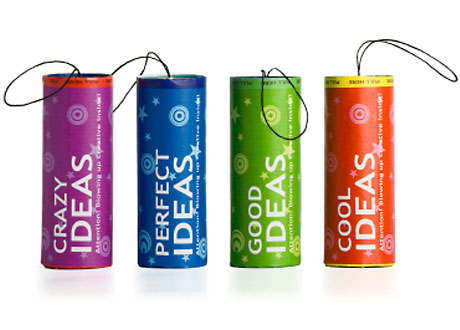
How to Begin the Process of Open Innovation
by John Kapeleris
Open innovation is the process by which organizations use both internal and external knowledge to drive and accelerate their internal innovation strategy in order to fulfil existing market needs or to access new market opportunities.
The concept of open innovation implies that an organization has the willingness and desire to source and utilize external knowledge, ideas, intellectual assets and technologies, in addition to its internal capabilities, to identify solutions to problems, capitalize on opportunities, develop new technologies, create new products and services, improve processes, or design new organizational systems and business models. However, in practice it is still difficult for organisations to understand how to embark on an open innovation journey and begin implementing the concepts of open innovation. It takes significant cultural change for an organization to embrace open innovation thinking.
A simple approach for organizations to begin to implement an open innovation strategy is to focus on their key challenges or problems facing the organization. A key question could be, “How can the organisation solve a significant complex problem utilizing external expertise or knowledge (that is, assuming internal attempts to solve the complex problem were not successful)”? One way of answering this question is to use a crowdsourcing approach.
Crowdsourcing refers to the outsourcing of tasks and activities, traditionally performed internally by an employee or an external contractor, to a large group of people (a crowd), through an open innovation approach or an open call.
In their book Wikinomics Don Tapscott and Anthony Williams discuss how mass collaboration can impact big changes in business. They also present a number of case studies of successful outsourcing and collaboration, including Goldcorp and Proctor & Gamble.
In the case of Goldcorp, a Canadian gold mining company, after internal reports and advice from technical staff indicated that the gold mine had run out of gold, the CEO placed all the geological studies, surveys and reports related to the gold mine into the public domain via the Internet and offered a sum of money to whoever could come up with new information or leads for new gold deposits. The CEO’s strategy was successful. New computer modelling technology located in another small organization was able to predict the location of new gold deposits using the existing geological survey data.
By utilizing an open call to an undefined group of people (generally through the Internet), the call brings together people who are in the best position to be able to solve complex problems, provide new ideas and develop new opportunities.
Crowdsourcing has a number of advantages, however, it can also result in intellectual property (IP) issues, including ownership issues and confidentiality of IP. An appropriate governance process is required to ensure the disadvantages of crowdsourcing are minimized. Some of the advantages of using a crowdsourcing approach can include:
* Reducing transaction costs of organisations
* Finding new business opportunities
* Building appropriate teams by finding the right external people
* Re-using previous work
* Building user defined products and services
* Solving difficult and complex problems
A number of online sites are available that specialise in bringing together different parties or groups to work on a particular project or solve a specific problem. Alternatively an organisation can also ask a question through one of its online networks such as Facebook or LinkedIn. A selection of crowdsourcing sites of interest are outlined below:
* Chaordix ( http://www.chaordix.com/ ) – Business innovation – Engaging crowds through the web to solve your business problem
* Ninesigma ( http://www.ninesigma.com/) is the most experienced and advanced Open Innovation service provider in the world.
* Innocentive ( http://www.innocentive.com/ ) – Problem solving – Brings together seekers who have a problem together with solvers from around the world who may be able to help
* Ideaconnection ( http://www.ideaconnection.com/ ) provides businesses with innovative, high quality, and timely solutions to their business and R&D challenges using teams of highly motivated experts located throughout the world led by world-class facilitators.
* Innovationexchange ( http://www.innovationexchange.com/ ) is an online open innovation marketplace. It's where diverse community members from all over the world respond to challenges sponsored by Global 5000 companies and not-for-profit organizations.
* Brightidea ( http://www.brightidea.com/ ) is a one-of-a-kind 'Facebook-style' software platform that allows Global 2000 businesses to monitor the social process of innovation, from concept to cash.
* Spigit ( http://www.spigit.com/ ) is an innovation tools vendor which provides a platform that can be used to create open communities to capture, evaluate, contribute to, and select ideas for implementation.
* Global Idea Bank ( http://www.globalideasbank.org/site/home/ ) – Social innovation – A site which collects social inventions that can change the world, which are rated by online voters.
Crowdsourcing as a strategy for open innovation has huge potential, including the ability to provide organizations with an open innovation access to a wider variety of expertise, resources and technology.
Open innovation has the ability to identify solutions to complex problems, capitalize on opportunities and develop new technologies which would not have been possible if the organization had merely looked internally for ideas.
Using external knowledge also brings with it the potential to create new products and services, improve processes, or design new organizational systems and business models that simply would not have transpired if the organisation had not looked externally for solutions.
[ add comment ] ( 57 views ) | permalink |




 ( 3 / 791 )
( 3 / 791 )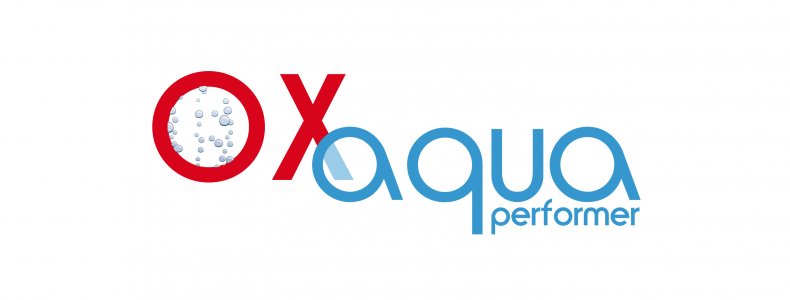
The ultra High barrier Eco-coating
Metalvuoto has recently introduced a high barrier water-based lacquers, creating an innovative coating range to be used on any kind of neutral film: this is Oxaqua.
Addressed to the wide market of food packaging and aimed to satisfy the need of visibility of the food inside the package, Oxaqua is extremely innovative in the filed of transparent flexible packaging.
Contrary to traditional multilayer films, Oxaqua is eco-friendly and reduces the packaging thinckness and weight.
Less material, less waste, less energy.
More efficiency, more convenience, more sustainability.
These are Oxaqua lacquered films features:
- Oxygen and aroma barrier
- Transparency
- Ease of use
The excellent Oxygen barrier ensures permeability levels less than 1 cc / m2 x 24 h - ASTM D3985. The Aroma barrier is remarkable as well.
Moreover, resistance to cracking test is excellent even after destructive Gelbo test cycles.
Thanks to transparency, Oxaqua makes the final packaging more appealing to consumers, who are the main vehicle to the market.
Metalvuoto’s lacquered films can be printed or laminated through traditional technologies which simplify the production chain and help the manufacturing process.
The absence of Chlorine and solvent makes water-based Oxaqua eco-sustainable and above all food approved, permitting direct contact with food.
For all this reasons, Oxaqua is the winning solution against traditional multilayer films and Chlorine-based coatings.
For information visit : http://www.metalvuoto.it/en/products/oxaqua
[ add comment ] ( 54 views ) | permalink |




 ( 3 / 2291 )
( 3 / 2291 )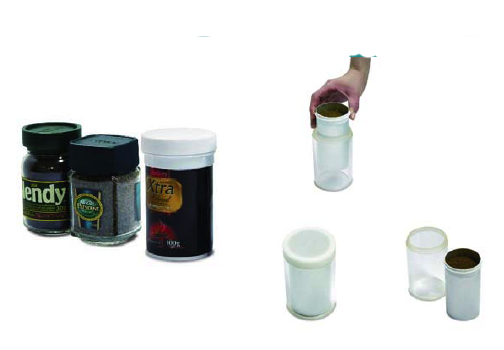
SOFT-BOTTLE is a new lighter and higher barrier than current plastic rigid bottles (made in HDPE, PP or PET resins) because of multilayers laminated film made cylinder of the body.
Soft-Bottle also uses less resin to save carbon dioxide release.
Also, gravure printing is available to catch customers' eyes.
Relief printing is another option for answering to small lot orders.
Pros
- Great Appearance
- Lightweight
- High Barrier
- Air-tight Reclosability
- Available in different sizes ( from 100 gr to 1 or more kg)
Produces and patented in Japan by Hosokawa Yoko company, if you are interesting to have more information, pls don't hesitate to call Idealpack or send us a mail at info@idealpack.it
[ add comment ] ( 67 views ) | permalink |




 ( 2.9 / 2211 )
( 2.9 / 2211 )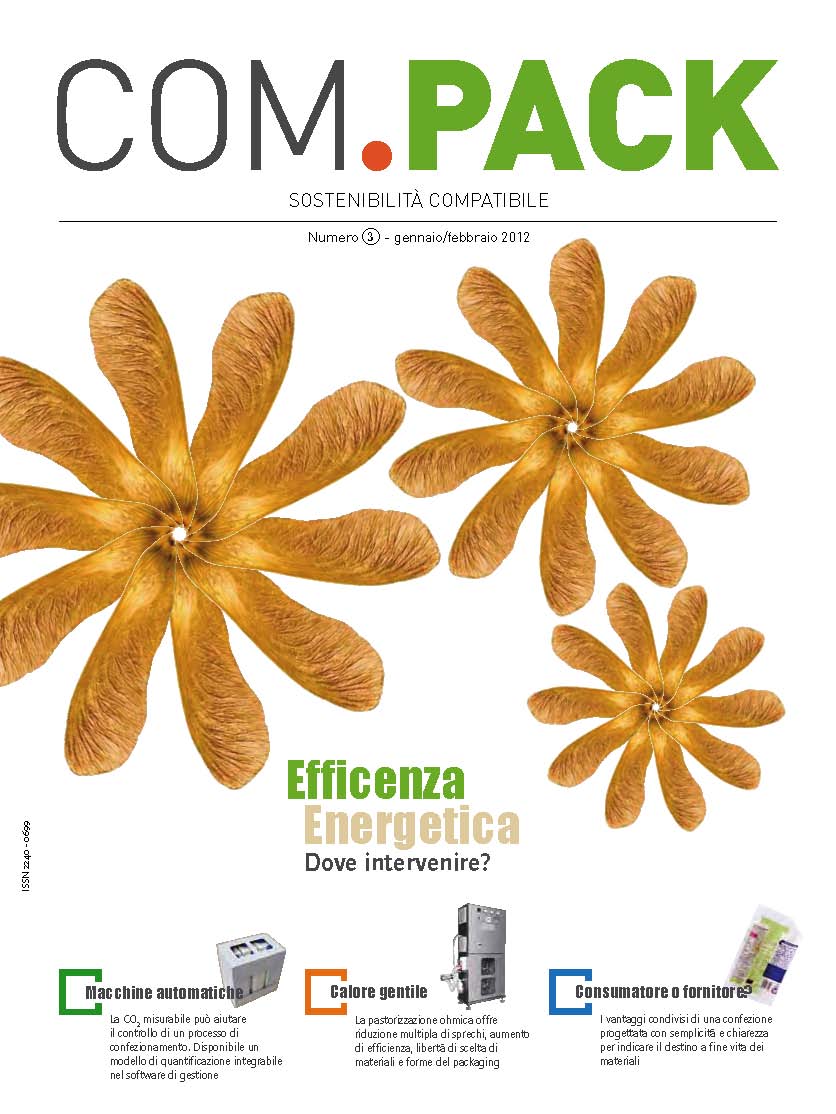
Lei è più ‘eco’ di me? Ma mi faccia il piacere!
di Giulio Ghisolfi
La patente di sostenibilità non è né facile né economica, e a volteneanche utile, da ottenere. E la LCA non è il giudice imparziale al quale rivolgersi
Se vi trovaste a voler definire quale frutto è migliore, vi cimentereste a comparare diversi tipi di frutta, per esempio una pera con una mela e/o con una banana?
Credo di no, è un esercizio non solo soggettivo ma soprattutto inutile, e dal punto di vista economico senza senso. Eppure è quanto succede nel nostro settore quando si vogliono comparare diverse tipologie d’imballaggi e cercare di sostenere che una confezione è più o meno eco-sostenibile di un’altra! Produttori di marca, distributori, utilizzatori ed enti locali sono sempre più interessati a rispondere al tormentone: se l’imballaggio X utilizza materiale riciclabile mentre l’imballaggio Y è riutilizzabile, quale dei due è più eco-sostenibile? E quindi, quale utilizzare? Anche in questo caso ci viene incontro la Direttiva Europea 62/94 che introduce un scala d’utilità (teorica) e identifica in termini d’importanza ciò che è preferibile dal punto di vista ambientale indicando quest’ordine di priorità:
1 - l’imballaggio riutilizzabile
2 - l’imballaggio facilmente (sotto il profilo economico) riciclabile
3 - l’imballaggio riciclabile con elevati costi
4 - l’imballaggio recuperabile energeticamente
5 - l’imballaggio non riciclabile/recuperabile destinato allo smaltimento con altre tecniche
Cominciamo con la prevenzione
Premesso tutto ciò, è essenziale che ogni azienda s’impegni in una continua politica di riduzione del materiale (spessore, peso, volume) utilizzato nel confezionamento per unità di prodotto finito realizzato: la premessa è ovvia, in quanto produce un risparmio soprattutto in termini economici.
Ne consegue che, per logica e buon senso, dovremmo immediatamente ridurre o eliminare, come soluzione tecnica di confezionamento, tutti gli imballaggi compositi/ accoppiati / multistrato: sono difficilmente separabili nei loro componenti.
Da evitare dovrebbe essere l’utilizzo di additivi chimici che sono ampiamente utilizzati per stampare, accoppiare e saldare; trovo sinceramente ridicolo etichettare e pubblicizzare come eco-sostenibili materiali quali, per esempio, la carta o i film in PLA quando poi la maggior parte della superficie viene stampata!
Tutto e il contrario di tutto
Se, quindi, accettiamo l’assunto che ogni materiale stampato o additivato (perché accoppiato, laminato, ecc.) non è ecosostenibile per le ragioni sopra dette, potremmo scoprire che invece lo è.
Come? Prendiamo in considerazione altri parametri quantitativi, come il peso della confezione, la quantità di prodotto per confezione, il tipo di processo utilizzato e il costo complessivo: sono tutti parametri anch’essi inclusi nella definizione di sostenibilità (parlo di quella economica).
Ecco che arriviamo a dimostrare il contrario di quanto appena detto: infatti, risulterebbe che gli imballaggi flessibili multistrato (tipo buste, flow-pack ect), considerati non riciclabili ed altamente ‘inquinanti’ perché difficilmente smaltibili, grazie invece alla loro versatilità, al limitato ingombro e soprattutto alla maggior leggerezza rispetto a qualsiasi altro tipo d’imballaggio hanno ed avranno soprattutto in futuro un utilizzo sempre più ampio!
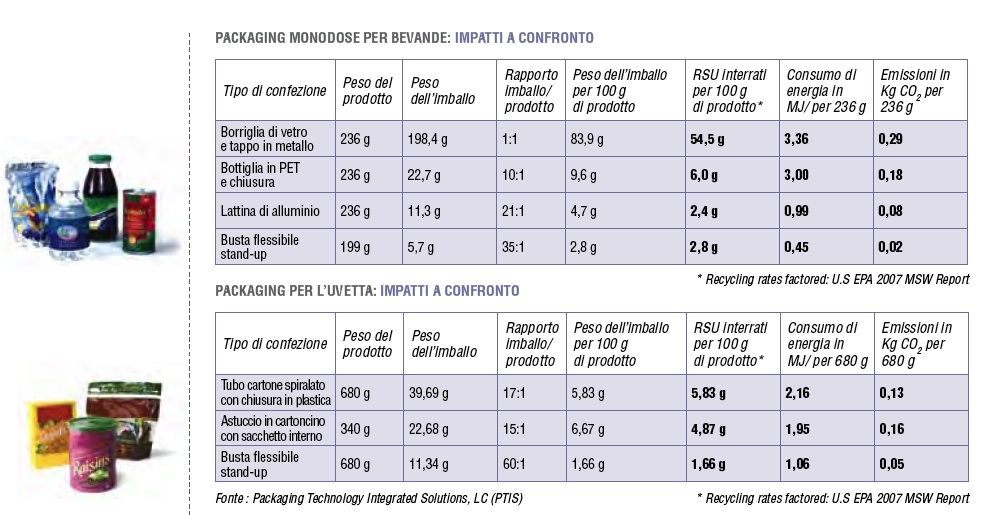
LCA? Non e’ un vangelo!
Allora cosa e come si può fare per valutare al meglio l’impatto ambientale delle confezioni utilizzate? Le primarie aziende di prodotti di largo consumo si sono dotate da alcuni anni di uno strumento analitico chiamato LCA (Life Cycle Assessment) che è stato messo a punto con l’obiettivo di facilitare la comprensione dell’impatto ambientale; anche per l’imballaggio utilizzato consente di misurare gli effetti che questo provoca sull’ambiente (in termini di emissioni di CO2 o Carbon Foot Print, di consumi energetici (kWh) o Gross Energy Requirement, ed infine in termini di consumo dell’H2O o Water Footprint, di eutrofizzazione, ecc.).
È questa la soluzione definitiva o soltanto un strumento utile?
Per la sua caratteristica di strumento meramente analitico ad uso interno, poiché basato su algoritmi creati ad hoc che utilizzano dati interni all’azienda (di per sé poco trasparenti e non verificabili), risulta a mio avviso essere uno strumento poco attendibile e facilmente manipolabile.
Ci capita sempre più spesso di condividere presentazioni pubbliche fatte per dimostrare l’eco-sostenibilità di un imballaggio prescelto basate su LCA: avete notato che tutte risultano sempre migliorative rispetto all’esistente in almeno uno dei parametri utilizzati?
Si parla sovente di - x% di emissione di CO2, - y% d’utilizzo di H2O, - z% di kWh.
Qual è il punto debole di questo ricorso alla LCA?
La risposta è che si tratta di uno strumento soggettivo facilmente manipolabile, che manca soprattutto di un’analisi comparativa approfondita tra diversi tipi di materiale utilizzabili unitamente ai diversi sistemi di processo e di confezionamento utilizzati. Inoltre, dati immessi, procedure di analisi e risultati dovrebbero essere certificati da un ente esterno neutrale e indipendente, cosa che oggi non avviene.
Siccome questa comparazione è decisamente molto complessa e soprattutto costosa, in quanto i parametri sono molteplici e di difficile valutazione, si preferisce limitarsi al conosciuto, all’esistente e, nel caso di comparazione, di una mera e semplice analisi dei costi dei materiali di base.
Uno strumento con molti limiti
Valutare quindi l’impatto ambientale di un imballaggio tradizionale in contrapposizione ad un imballaggio più sostenibile, pensato e realizzato per venire incontro alle esigenze del mercato, utilizzando la LCA, è semplicemente impossibile, inutile e sopratutto anti-economico. Lo strumento LCA è quindi da considerare come strumento tecnico non rivolto verso l’esterno, ma verso l’interno (per gli addetti ai lavori): può facilitare unicamente il miglioramento continuo di un prodotto già esistente.
Anche per quanto riguarda, invece, il suo utilizzo nello sviluppo di un prodotto nuovo, come ‘eco-tool’ la LCA risulta a mio avviso fuorviante e dannosa, in quanto tende a preservare l’esistente, mentre la soluzione ottimale più eco-sostenibile deve essere ricercata nella conoscenza approfondita dell’interazione del sistema prodotto (materiale+processo+prodotto) che è molto complessa e difficilmente sintetizzabile e/o parametrizzabile.
Questo compito rimarrà in mano alla sensibilità ambientale dello sviluppatore incaricato che potrà sì avvalersi di strumenti conoscitivi quali la LCA, ma che dovrà soprattutto essere sapientemente capace di mescolare le innovazioni affidabili meno impattanti che la tecnologia gli metterà a disposizione mantenendola sostenibilmente competitiva rispetto all’esistente.
[ add comment ] ( 124 views ) | permalink |




 ( 3 / 2528 )
( 3 / 2528 )Top Heinz managers keep innovation center- of-plate and help push the limits of the company’s packaging developments.
“To do a common thing uncommonly well brings success.”
— Henry John Heinz, Founder

For an impressive body of work accentuated by the latest package introductions noted in this story, we are pleased to name Heinz as our Food Packager of the Year.
Heinz Co., Pittsburgh, is an iconic, $10.5 billion global food packager that remains “Hungry, humble and focused”—its three foundational tenets to innovation.
Overseeing the company’s alignment to these tenets as it continues on a fast track in package innovation are Jim Matthews, Group VP – R&D/Innovation, Heinz North America and Emerging Markets Capabilities; and Michael Okoroafor, Ph.D., VP, Global Packaging Innovation and Execution. What does innovation mean to Heinz and how does packaging fit in?
“Quite simply, we define innovation as turning new ideas into profit,” responds Matthews. “While innovation can be a high-tech solution, it also can be a straight-forward consumer insight based on thoughtful enhancement that can disrupt and grow a category.
“Packaging is a major part of creating value for our products.
Our R&D and packaging teams are tightly linked with our marketing teams.
A major part of my role is creating the culture, tools and talent that will allow Heinz to excel in the marketplace with value added, conve- nient, purposeful and sustainable packaging designs and enhancements. I judge our packaging team to be one of the best in the business, and an enabler to developing the strategic partnerships and results that help our businesses grow together.”
Okoroafor also sees packaging as an enabler, and also points out another critical focus: the consumer.
“There are a lot of insights that go into understanding consumer needs, desires and wants. That’s how we formulate our strategy for addressing innovation. We view technology as an enabler to get us to where the consumer wants us to be.
“Secondly, most of our packaging is designed to communicate to the consumer,” says Okoroafor, “and, in most cases, simplify the way our customers go to market.”
There’s a third crucial component in Okoroafor’s view. “We incorporate sustainable features into our packaging in the most environmentally friendly way possible. To quote our chairman [William Johnson], it’s a case of ‘doing well by doing good’.”
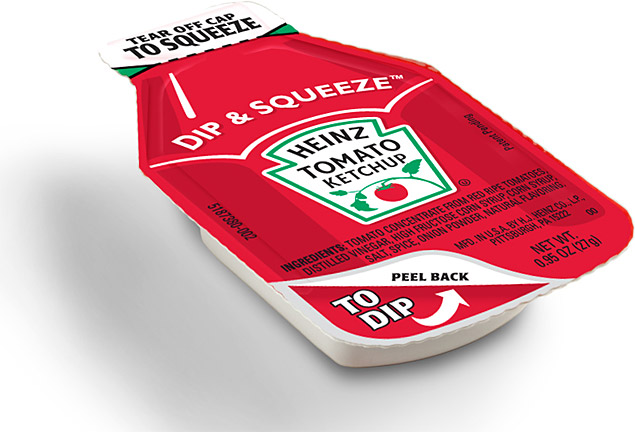
Listening and responding through innovation
Look no further than the thermoformed, packet-replacing Dip & Squeeze® foodservice ketchup packs as a prime example of what can result from listening to the consumer.
As the first transformational packaging innovation in the sachet foodservice industry in more than 40 years, Matthews believes that the Dip & Squeeze platform “really demonstrates the power of clear consumer and operator insights, intellectual property and affordable, intelligent design.”
Comprising a peelable lid applied to a small thermoform and resembling a small bottle, Dip & Squeeze allows consumers to either tear off the tip and squeeze the condiment out or peel back the lid from the bottom for dipping. The pack holds 27 grams of ketch- up (just short of a full ounce), about three times the amount of a standard foodservice packet.
“We listened to the consumer over the years regarding some of their concerns with our ketchup sachet packaging. We went to work and as science and material technologies improved, we were able to leverage that into what you see today,”says Okoroafor.
Besides the structural, materials and package de- sign aspects for Dip & Squeeze, the development had a considerable machinery side that itself took 16 months development. Working with Multivac (www. multivac.com), the result was “a robotics-driven packaging machine that’s the size of a football field,” says Okoroafor.
“It’s a fascinating piece of technology.”
The pack has proven such a hit that, last month, Heinz announced it was taking the concept into retail in 10-count cartons. It marks the first time a Heinz ketchup innovation developed for restau- rants has made the transition to store shelves.
Okoroafor points to sustainability-driven initiatives the company has championed as exemplifying “doing well by doing good.”
One of those is for bagged meals, such as those packaged at the company’s Pocatello, ID, facility.
Traditionally, frozen meals at Heinz were produced in trays made from crystallized PET (CPET). According to Okoroafor, going from CPET trays to bag meals uses approximately 80% less material [by weight] and offers multiple benefits to consumers, customers and the environment.
“The bag meal is very convenient, easy to transport, and easy to store in the refrigerator. And, from a merchandising perspective, our design is better than the competition because it sits better on the shelf.”
Matthews understandably also feels good about the development, though it’s also apparent that Heinz doesn’t take its foot off the accelerator even when it has a winner.
“It hits on all cylinders from a standpoint of taste, freshness, convenience and eventually sustainability as well,” he states, “but it’s an- other platform we are continually refining.
We are applying this technology to brands like T.G.I. Friday’s, Smart Ones, Ore-Ida and globally with infant feeding with great success.”
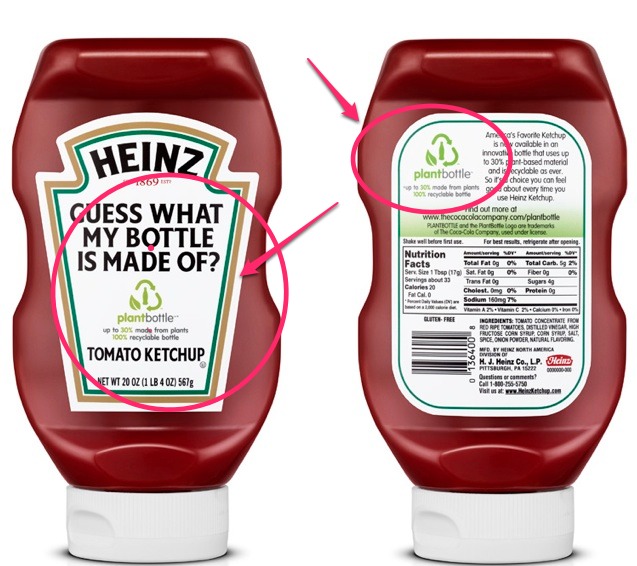
‘PlantBottling’ a winner
Another remarkable success story is Heinz’s unprecedented strategic partnership with the Coca-Cola Co. and its PlantBottleTM technology.
It’s yet another unique facet for this sustainability-conscious food packager to effectively leverage existing technology in a win-win arrangement.
Made from up to 30% renewable sugar cane ma- terial, the PlantBottle looks, feels and functions just like traditional PET plastic and is 100% recyclable. The PlantBottle runs exactly the same way in production and has the exact same shelf life as standard PET bottles.
“Absolutely no difference,” emphasizes Okoroafor, who possesses a doctorate in polymer science. From a technical standpoint, the 30% renewable content in PlantBottle is monoethylene glycol, the same material derived from petroleum sources.
Currently, all Heinz 20-ounce ketchup bottles are made from PlantBottle packaging. It’s the biggest change to Heinz’s iconic ketchup bottles since plastic bottles were introduced in 1983.
Okoroafor had been part of the team that developed the PlantBottle at Coca-Cola Co.
“Because the companies complement one another in several ways and have a long history of shared values, it was easy for us to work together,” says Okoroafor.
The company is collaborating with Coca-Cola Co. towards reaching 100% renewable content. “The other 70 percent is very challenging,” Okoroafor says. “You’re going to be hearing more from this partnership.”
It also exemplifies an approach Okoroafor defines as “leveraging ourself into prosperity, not inventing ourself into prosperity. Inventing a molecule that would substitute for PET is not our core competency. What we do best is meet consumer needs. That’s why people and companies like to grow with us.”
Heinz will produce 120 million PlantBottle packages in 2011.
This wasn’t Heinz’s first foray into a renewable platform. About six months before the PlantBottle partnership, it debuted Simply Heinz brand foodservice condiment packets that use 30% renewable materials as its launch into renewable packaging.
Even the standard PET bottle has been slimmed: The current Heinz ketchup bottle uses 20% less polymer than five years ago, according to Okoroafor. “We have constantly lightweighted to where it is very efficient.”
The company is also using recycled content into its packaging, which Okoroafor consider as very important and fits into the 4 Rs of Heinz sustainability: Re-use; reduce; recycle; renewable. “Depending on which product we’re delivering, we leverage some or all of these pillars,” he explains.
To what does Heinz attribute its successful track record?
“To grow, innovation must be sustainable in terms of new product success rates,” offers Matthews. “We leverage consumer insights at every step in the process. This ensures our investment in new products will pay out and generate an ongoing return.”
And that won’t stop, even against the backdrop of a sputtering economy where other companies have entrenched. “One thing I can tell you is that we haven’t stopped investing in packaging,” shares Okoroafor.
Managers seem to have taken the company Founder’s advice a step further by “doing an un- common thing uncommonly well” with some frequency. And that means that all the competition can do is try to play catch up.
Source : Food & packaging magazine by Rick Lingle
[ add comment ] ( 126 views ) | permalink |




 ( 3.1 / 2349 )
( 3.1 / 2349 )

 Calendar
Calendar